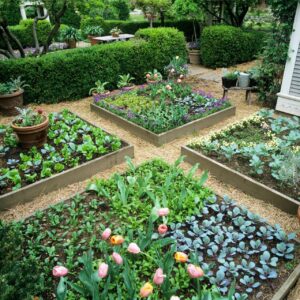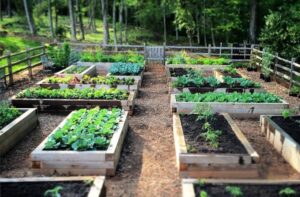
We all know that how soil is an important factor for growing any crop, it is the ultimate life giver to all the crops that a farmer plans to grow. But, nowadays a farmer has to undergo too many complications even to grow a single crop. To cater to some of these there is a solution which is raised bed cultivation. Now, the question arises what is raised bed farming, and how to grow vegetables in raised beds? In this article, we will discuss all the questions regarding what are the objectives, challenges, and how to build a raised bed.
What are Raised Beds
The raised bed cultivation system is a management strategy in which the soil in which the farming is done is raised above the soil up to some cm depending upon which crop we are going to sow into the soil. The raised beds are constructed upon the normal or natural grade of the soil. With raised beds, the farmer can get higher yields of their crops which he can never get by using the normal or on the flat surface of the soil. Raised beds are a very good option for small farmers to grow a successful crop in the area. These are often more productive and only capture very little space. Raised beds are a very useful strategy, especially in areas where there are drainage issues because with the help of raised beds, there is better drainage.
Need of Raised Beds
Many times farmers go through drainage as well as nematode issues and the small farmers are unable to find a solution to these issues which results in soil that has poor nutrient status, too much moisture that is not suitable for the crops to grow, or majorly infested with the nematodes. S, to cater to this issue the ultimate solution is a raised bed strategy. The raised bed helps to keep the proper drainage in the soil and also to keep the soil a little warm which will make seeds germinate easily and the nematode problems which affect the growth of the plant will also be reduced with this strategy.
Benefits of Raised Beds
Higher Soil Quality: Raised beds provide greater control over soil composition, resulting in higher fertility and structure. The addition of organic matter, such as compost and aged manure, and soil nutrients, promotes healthy plant growth.
Enhanced Drainage: Too much water can be harmful to plant health, producing root rot and other water-related problems. Raised beds have good drainage, which prevents waterlogging and maintains appropriate moisture levels for plant growth.
Weed Control: The elevated position of raised beds makes it more difficult for weeds to take root and compete with crops for nutrients and sunshine. This eliminates the need for herbicides and laborious weeding, saving farmers both time and effort.
Warmer Soil: In cooler climates, raised beds absorb and retain more heat from the sun, resulting in a warmer microclimate that allows for earlier planting and a longer growing season. This is especially useful for heat-loving crops such as tomatoes and peppers.
Accessibility: Raised beds are more accessible for planting, and harvesting, particularly for people with movement challenges. The higher height lowers the need to bend, making gardening more comfortable and also visually pleasurable for everyone.
Raised beds are ideal for growing a diverse range of vegetables and flowers. Here are a few popular choices:
Raised beds for Vegetables:
Tomatoes: Grow in the warm, well-drained soil of raised beds, producing abundant yields of juicy fruits.
Lettuce like the loose, fertile soil of raised beds, provides better air circulation and reduces the danger of fungal diseases.
Carrots benefit from raised bed’s loose, stone-free soil, which produces straighter roots.
Peppers: Flourish in the warm, sunny conditions raised beds provide, producing larger and more flavorful fruits.

Raised beds for gardening:
Roses: Raised beds provide better drainage and soil aeration, resulting in stronger plants and more brilliant flowers.
Marigolds: Marigold flower likes to flourish in well-drained soil and raised positions of raised beds, attracting beneficial insects and deterring pests.
Zinnias: Thrive in the warm, fertile environment of raised beds, producing a lot of colorful flowers throughout the season.
Lavender: Benefits from the improved air circulation and drainage of raised beds, resulting in stronger growth of Lavender also.
To do farming you don’t need a very big farm raised beds for terrace gardens are also an option for urban people to grow crops that are healthy for them. The points of how to prepare a raised bed are discussed below.
Preparation of raised beds:
- Select a Site: Choose a location that receives adequate sunlight and has good drainage. Avoid areas which are prone to flooding.
- Design Flexibility: There are no strict rules for constructing raised beds, gardeners can choose between ready-made kits to make a raised bed.
- Clear the Area: Remove any weeds, grass, rocks, or debris from the site. It is essential to have a clean, even surface for the raised beds.
- Size Considerations: Raised beds ideally shouldn’t exceed four feet in width to ensure easy access without compacting the soil so that we can easily do cropping in them. They can be any shape or length.
- Height: Aim for raised beds at least six inches tall to provide sufficient soil depth for healthy root growth, with a foot of soil being optimal for many vegetable crops.
- Materials: Opt for non-treated, rot-resistant lumber like cedar or oak, or consider alternatives like bricks, rocks, or plastic decking material. Avoid treated wood due to concerns about leaching toxins.
- Soil Composition: While soilless potting mix is an option, it can be expensive. Instead, fill raised beds with a mix of quality garden soil and compost, aiming for no more than 50% organic matter with compost comprising 10-20%.
- Placement: Locate raised beds in spots receiving at least six hours of direct sunlight daily and near a water source for easy irrigation. Leave sufficient space between beds for accessibility and maintenance.
- Planting: Once the raised beds are prepared, you can start planting your desired crops. Follow spacing recommendations and planting depths specific to each plant species.
- Maintenance: Regularly monitor the raised beds for weeds, pests, and diseases. Water as needed and replenish the soil with compost or organic fertilizers to maintain fertility throughout the growing season.

Informative
Great